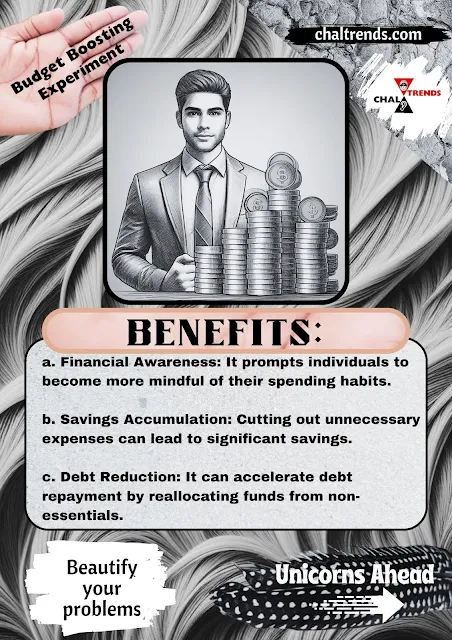Introduction:
In a world where spending has become second nature, the concept of the "No-Spend Challenge" has gained significant traction. This trending money-saving experiment challenges individuals to abstain from non-essential spending for a set period. But is it truly worth it? In this post, we'll explore the benefits, potential drawbacks, and tips for success in undertaking the No-Spend Challenge.
1. Understanding the No-Spend Challenge:
The No-Spend Challenge involves committing to refrain from spending money on non-essential items or activities for a predetermined period. This could range from a week to a month or even longer, depending on personal goals and circumstances.
2. Benefits of the No-Spend Challenge:
a. Financial Awareness:
The challenge forces participants to confront their spending habits and become more mindful of where their money goes.
b. Savings Accumulation:
By cutting out unnecessary expenses, individuals can accumulate significant savings over the challenge period.
c. Debt Reduction:
For those with debt, the No-Spend Challenge can be a powerful tool for accelerating debt repayment by reallocating funds that would have been spent on non-essentials.
3. Potential Drawbacks:
a. Social Limitations:
Participating in the challenge may require declining social invitations or finding free alternatives, which could impact social interactions.
b. Initial Discomfort:
Adjusting to a more frugal lifestyle may be challenging initially, especially for those accustomed to frequent spending.
c. Difficulty Sustaining:
Some individuals may find it difficult to sustain the challenge for an extended period, leading to frustration or feelings of failure.
(Don't stop here! We have more exciting content related to Budgeting waiting for you)
4. Tips for Success:
a. Set Clear Goals:
Define specific objectives for undertaking the challenge, whether it's saving for a particular expense or breaking free from the cycle of overspending.
b. Plan Ahead:
Anticipate potential challenges and plan alternative activities or strategies to avoid temptation.
c. Stay Accountable:
Share your commitment with friends or family members who can offer support and encouragement throughout the challenge.
d. Celebrate Milestones:
Acknowledge and celebrate small victories along the way to stay motivated and inspired to continue.
5. Real-Life Success Stories:
a. Sarah, the Budgeter:
"I never realized how much I was mindlessly spending on impulse buys. The No-Spend Challenge forced me to be mindful of my purchases. I planned meals, found free entertainment, and even used this time to declutter and sell unused items. By the end, I saved a significant amount and felt more in control of my finances. Now, I budget more effectively and avoid unnecessary spending."
b. David, the Minimalist:
"The challenge helped me break my bad spending habits and appreciate the things I already own. I rediscovered the joy of reading books I already had instead of buying new ones, explored free local parks instead of expensive outings, and even learned to cook with leftover ingredients. Not only did I save money, but I also found myself spending more quality time with family and friends."
6. Is It Worth It?
While the No-Spend Challenge can yield significant financial benefits and promote mindful spending habits, its worth ultimately depends on personal priorities and willingness to embrace temporary lifestyle changes.
7. Call to Action:
Ready to test your spending habits and potentially kickstart your savings journey? Consider embarking on your own No-Spend Challenge! Remember, this experiment is meant to be flexible and adaptable to your unique circumstances.
To help you get started:
a. Define your goals:
What do you hope to achieve through this challenge? Is it building an emergency fund, saving for a specific purpose, or simply gaining greater awareness of your spending habits?
b. Choose your timeframe:
Start small! A 24-hour or weekend challenge might be a good introduction. Gradually increase the duration as you feel comfortable.
c. Plan your essentials:
Ensure you have enough funds to cover necessary expenses like rent, groceries, and transportation during the challenge.
d. Explore alternatives:
Be creative! Find free or low-cost activities to replace your usual non-essential spending. Explore libraries, parks, museums with free admission days, or home-cooked meals with friends and family.
e. Track your progress:
Monitor your spending during the challenge and celebrate your achievements! This will help you stay motivated and gain valuable insights into your spending patterns.
8. Conclusion:
The No-Spend Challenge presents a unique opportunity to reevaluate spending habits, prioritize financial goals, and cultivate a more intentional approach to money management. While it may involve temporary sacrifices and challenges, the potential long-term benefits make it a worthy experiment for those seeking to improve their financial health and achieve greater financial freedom.
(Don't stop here! We have more exciting content related to Budgeting waiting for you)










.jpeg)





0 Comments